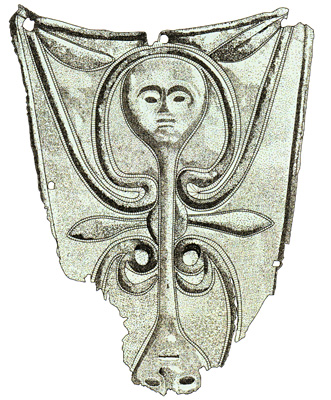
IAN ARMIT. Headhunting and the body in Iron Age Europe. xii+260 pages, 86 illustrations, 5 tables. 2012. Cambridge: Cambridge University Press; 978-0-521-87756-5 hardback £60.
Review by Katharina Rebay-Salisbury
School of Archaeology and Ancient History, University of Leicester, UK
(Email: kcrs1@le.ac.uk)

Today, 'headhunting' is a term more often used in employment recruiting than in later prehistoric archaeology. Ian Armit's book, however, makes a convincing case that societies in Iron Age Europe did indeed engage in practices for which 'headhunting' is an appropriate description. The opening chapter of the book defines the vocabulary used and clarifies the meaning of headhunting, head veneration, cosmology, religion, ideology and ritual violence. Armit defines headhunting as "a form of group-sanctioned, ritualised violence, in which the removal of the human head plays a central role" (p. 11).
That Iron Age societies have emphasised the human head in art and ritual practice is of course not news; it has traditionally been explained in terms of a Europe-wide 'head-cult' characteristic of the Celts. Taking Classical as well as Irish and Welsh literary sources into account, Armit critically reviews the history of this interpretation, contextualises the sources and explains how they relate to each other.
Armit's digest of the anthropological literature on headhunting with examples ranging from Amazonia to Indonesia is clearly written by an archaeologist for archaeologists in that he considers how the ethnographic evidence would be reflected in the archaeological record. It is a refreshing stance, which takes old ethnographies seriously while taking care to retain the historical trajectories from which the practice of headhunting arises. More often than not, headhunting happens in times of political uncertainty and change, but rarely is headhunting just a by-product of war: recurrent beliefs all over the world associate the taking of heads with concerns about group cohesion, aspects of power and fertility. A central problem of interpreting the archaeological evidence for the curation, display, representation and deposition of heads is the difficulty of differentiating whether the human remains belong to the in-group or the out-group, if they are closer to being ancestors or enemies. Particularly interesting are examples where artistic representations of heads come to replace "the real thing"—this is a topic that could have been explored in greater depth.
Whilst Armit starts almost every chapter in this book with an example of noteworthy depositions of human remains from the British Isles, his main evidence is located in southern France. Ritual sites such as Roquepertuse, but also the Sculptor's Cave in Scotland and Trou de Han in Belgium, are described in quite some detail. The author succeeds in evoking a mystical atmosphere through drawing on sensual aspects of the sites.
The core of the book is a detailed account of the Provençal sites and stone monuments of Roquepertuse and Entremont. Pillars with superimposed, carved heads from Entremont, Badasset and the sanctuary at the source of the Seine form his main argument for a link between head cult and fertility. The warrior statues of Entremont, sitting cross-legged, with several severed heads on the lap, paint the most graphic picture of what headhunting actually must have looked like.
The development of the sanctuary of Roquepertuse is tackled in considerable detail, as it is probably the best understood in this region. It is set in the context of the rise and fall of the Saluvii and explained by political power struggles at the fringes of the Graeco-Roman world. Pillars and lintels with niches to display human heads have sparked the imagination of generations of researchers, but this particular incarnation of the sanctuary seems to have been surprisingly short-lived. It was not, however, the only one of its kind, and Armit marshals the less well known evidence from the region to strengthen his arguments.
Disappointingly Armit's Europe does not extend much further east than France. Well-known sites like La Tène, Manching and Basel Gasfabrik are mentioned just once (p. 196), whilst evidence further east is ignored entirely. The pre-Roman Nesactium, Croatia, for instance, revealed intriguing fragments of stone sculpture (including a Janus-head) dating to the sixth century BC (Mladin 1966; Fischer 1984). The recently excavated and not yet fully published excavations at Frauenberg near Leibnitz and Roseldorf, both in Austria (Tiefengraber & Grill 2008; Holzer 2008), are just two examples of late La Tène sanctuaries in which the role of human skulls and other fragments of the human body may be further explored. It is probably true that the archaeology of southern France paints the clearest picture of the story Armit wants to tell, but it remains unclear if this can be extrapolated to the rest of Iron Age Europe, or what alternative models in other regions could add to his interpretation.
The final chapter ventures into fashionable themes in studies of the human body—the boundaries of humans and animals, hybridity, fragmentation and personhood. This chapter appears to have been written as an afterthought, and could have been better integrated with the examples described in this book. A lot more could have been said about these important issues. Nevertheless Armit's book is well worth reading. It is well written, describes the southern French examples in detail, adds some valuable insights into other selected sites in western Europe, and lays out the arguments without pre-supposing too much knowledge. His clear, colourful writing style, supported by sufficient black-and-white drawings and photographs, makes the book accessible to a wide audience.